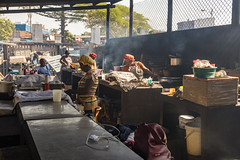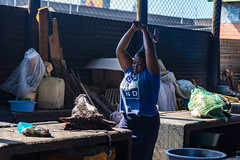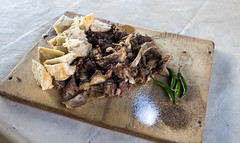Hold on to your seats, I’m putting the “Offbeat” solidly back into “Offbeat Eats”.
When we first arrived in Durban, we took the coastal Highway 2 up the Eastern Cape, past Richards Bay. As we passed through the minor town of KwaMsane around 4pm local time, we noticed a stretch of highway where several dozen groups had all set large cooking fires with metal pots, and were preparing meals, many of them preparing to sell them roadside. The food wasn’t ready yet, and we were actually in a bit of a hurry to get to the Zulu Nyala lodge, but I was curious. Several days later, talking to our Zulu Nyala guide, he told me that what they were preparing was a local dish, “Inyama yenhloko”, which means, literally, “head meat”. It’s a traditional Zulu dish, especially for special occasions and for the head of the family, although it’s gotten broader acceptance more recently.
The process is simple: fresh bovine heads are collected, they skin the heads, cleave the meat off the skulls (usually with an axe), and boil the meat in large pot of salted water, along with some cornmeal bread. It’s then all chopped up, lightly seasoned with a seasoning mix, and served on a wooden board with salt, pepper, and chiles. I was intrigued, but our travel plans didn’t have us driving down any Zulu-region highways at dinner time.
But our last full day in Durban had us taking a Cultural Walking Tour of Durban run by a local named Johnny, who showed us many of the various cultural aspects, and sometimes the grittiness, of Durban. It was a very insightful tour, and after seeing the Durban skyline, and visiting several of the area markets, he took us to a very special niche market right outside the Early Morning Market: the very aptly-named Bovine Head Market. As the British saying goes… “it does as it says on the tin.” A market dedicated just to the butchering and preparation of bovine heads.
Yes, we were actually going to be able to try “Inyama yehloko”. This wasn’t for the faint of heart; on a typical American scale of 1 to 10 for food handling procedures, this weighed in around “2”, although there was actually was the “more sanitary” approach; back around the end of Apartheid, street vendors (previously tightly regulated by the police, who wouldn’t have allowed such a scene), set up shop in the street outside the Early Morning Market, and were renowned for thawing frozen cows heads on the median, leaving offal in the gutter, and a few other unsavory practices, and market organizers worked with the city to make a better solution, the current Bovine Head Market, with dedicated clean water, good drainage, concrete tables, and low-smoke stoves. So while this won’t win any food safety awards in the US, it wasn’t quite as bad as it first appeared, they often were cleaning off surfaces and dumping boiling water on things, and using a lot of older advertising banners as disposable work surfaces.
It’s still quite the sensory experience walking into the Bovine Head Market. It’s quite well-named, since one of the very first sights I saw was a series of cow’s heads lined up on one of the concrete tables, waiting to get butchered (note that these weren’t randomly-sourced, these were from one of the area butchers, with business names, size info, and date clearly affixed). From there, they get scalded to loosen the fur, and then several butchers (by cultural tradition, the food preparation here was strictly women) would take the heads and butcher them down to the bones (that’s the approach used here in the Market; in other places sometimes they’ll boil the entire head), resulting in piles of fresh heat, cheek, tongue, and neck meat. The butchering is a sight to behold, mostly done with large axes.
Then, several pots are run in back, each filled with a simmering salted and lightly spiced broth. The meat is simmered for several hours until tender, with the steam used to cook up a dumpling-like corn-bread. Once the food is ready, a large portion (approximately one tenth of the meat from a head, by my estimate) is ladled out of the kettle, roughly chopped, seasoned lightly with a spice mix, and served up on a wooden board (recently doused with boiling water in a minor attempt at some level of hygiene), along with some of the steamed bread, piles of salt and pepper, and a small pile of very hot chile peppers.
We definitely stood out as customers, both because we’re white foreigners, and because inyama yenhloko is traditionally considered a meal for male tribal leaders; however, they did happily serve up myself and Carol without hesitation. After ordering our portion (80 rand, about $5 American), we soon took our wooden board over to one of the large communal tables and worked on enjoying our feast. While this meal was the very poster child for what the travel clinic told me what not to do in South Africa…
This was good. Real good. Our portion was mostly tongue and cheek (both of which are tender and well-flavored), although there was also a bit of somewhat crunchy ear and snout in there as well. The cooking process is simple, but results in a deep, flavorful pile of meat that mostly tastes like good beef, albeit with a few odd textural bits. Admittedly, this wasn’t my first “random cow head parts” rodeo, having had more than a few Tacos de Cabeza in both Arizona and Mexico prepared under similar culinary conditions (and heck, the steamed cornbread wasn’t entirely unlike a good tortilla in flavor). The other diners at the table were friendly and welcoming, and everyone was glad we were enjoying our meal.
And hey, if you were wondering, neither one of us got sick, either. Although bring some sort of hand wipes, since I was fighting slightly tallow-greasy hands for the next hour or so.
While this is definitely on the adventurous end of my culinary explorations, and not something I’d recommend for just any of my readers (heck, I know several of my readers turned green back in paragraph two, and won’t even have read this far), but this really was a nice, enjoyable culinary treat, and certainly an “offbeat” one at that.







